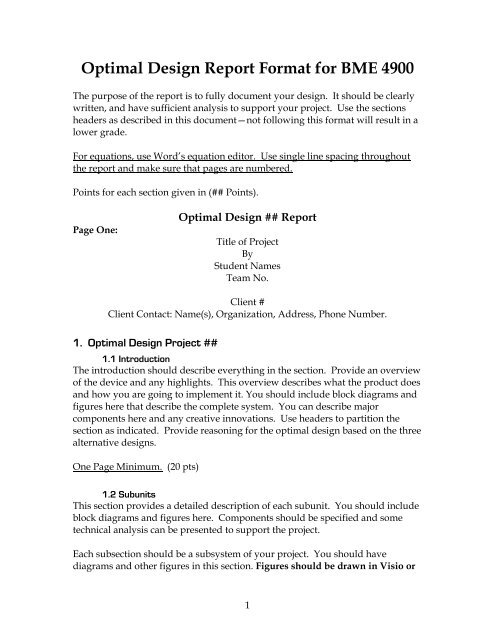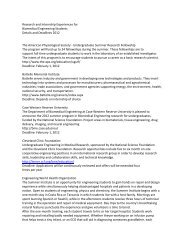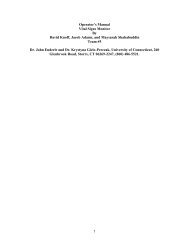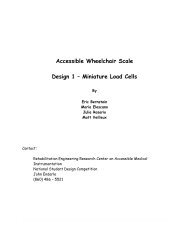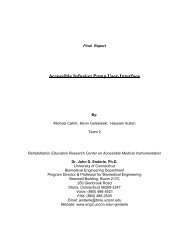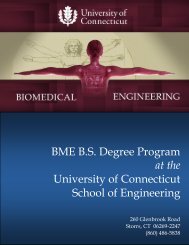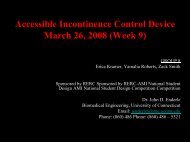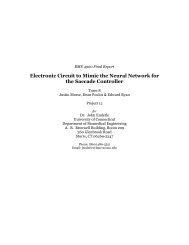Optimal Design Report Format
Optimal Design Report Format
Optimal Design Report Format
Create successful ePaper yourself
Turn your PDF publications into a flip-book with our unique Google optimized e-Paper software.
<strong>Optimal</strong> <strong>Design</strong> <strong>Report</strong> <strong>Format</strong> for BME 4900The purpose of the report is to fully document your design. It should be clearlywritten, and have sufficient analysis to support your project. Use the sectionsheaders as described in this document—not following this format will result in alower grade.For equations, use Word’s equation editor. Use single line spacing throughoutthe report and make sure that pages are numbered.Points for each section given in (## Points).Page One:<strong>Optimal</strong> <strong>Design</strong> ## <strong>Report</strong>Title of ProjectByStudent NamesTeam No.Client #Client Contact: Name(s), Organization, Address, Phone Number.1. <strong>Optimal</strong> <strong>Design</strong> Project ##1.1 IntroductionThe introduction should describe everything in the section. Provide an overviewof the device and any highlights. This overview describes what the product doesand how you are going to implement it. You should include block diagrams andfigures here that describe the complete system. You can describe majorcomponents here and any creative innovations. Use headers to partition thesection as indicated. Provide reasoning for the optimal design based on the threealternative designs.One Page Minimum. (20 pts)1.2 SubunitsThis section provides a detailed description of each subunit. You should includeblock diagrams and figures here. Components should be specified and sometechnical analysis can be presented to support the project.Each subsection should be a subsystem of your project. You should havediagrams and other figures in this section. Figures should be drawn in Visio or1
Solidworks. Each part/device should be described with a section in which thefollowing is covered: form, function, diagrams. Discussion on how you will testto subsystems should be included in each subunit, as well as how you willintegrate the subunits into a complete device and any testing procedures.You should choose an order of presentation, such as top to bottom that bestmeets your needs. Headings should be consistent, clear and standout.Analysis or some other support (i.e., protoboard testing, etc.) must be providedin each subsection to show proof that the project will work. Use Multisim,Matlab, Solidworks, FilterPro and other software packages for verification.10 Page Minimum. (60 pts)2 Realistic ConstraintsBased on the design, how are the following incorporated into the design project:Engineering standardsRealistic constraints that include most of the following considerations:economic; environmental; sustainability; manufacturability; ethical; healthand safety; social; and political.2 pages minimum. (5 pts)3 Safety IssuesBased on the optimal design, how is safety addressed (i.e., Electrical, Mechanical,Biological Hazards, Decontaminations, Chemical hazards, Radiation, Thermal,Biocompatibility, Host Reaction to Biomaterials). You do not need to discuss allsafety hazards in the previous list, just those that are relevant to your project.1 page minimum. (5 pts)4 Impact of Engineering SolutionsBased on the optimal design, describe the impact of engineering solutions in aglobal, economic, environmental, and societal context.1 page minimum. (5 pts)5 Life-Long LearningDescribe any new material learned and techniques acquired.2
1 page minimum. (5 pts)6 ReferencesList references using the style sheet below.Style NotesWriting Style Use simple and correct English, i.e., “use” not “utilize” or “usage,”“effected” not “impacted” (except for teeth). Remember, “data” is a pluralword.Parameters are what you fix, variables are what you measure, e.g.,“temperatures were set at 20, 30, and 40 deg. C. (parameters) andmeasurements were made of blood pressure and flow (variables).In describing portions of the paper, use the term “above” to refer toprevious statements and “below” to indicate what is to follow.Use metric (SI) units and abbreviations. Leave a space between the lastdigit of a number and its units. Use scientific notation for numbers, with aleading 0 for numbers less than 1, e.g., 0.23 ml.If a commercial product is mentioned, include model number along withmanufacturer, city and state (country).In general, do not use footnotes. For a sentence or two, just put thecomment in parentheses. For a paragraph or two, use a side bar.Alternatively, include with references as endnotes.To use an abbreviation or acronym, first spell it out, and then follow withthe abbreviation or acronym in parentheses. (This is not required forcommon units of measurement.) For plurals, do not use an apostrophe,i.e., use EEGs and 1990s, not EEG's and 1990's. “, et al.,” takes commas front and back, and one period; “, i.e.,” and “,e.g.,” take two commas and two periods.At the start of a sentence use “Figure 3”; within a sentence, use “Fig. 6” or“Figs. 8-10”.Use “2-D” and “3-D” for two and three dimensions.3
Mathematical NotationTo avoid errors in editing and typesetting, authors should clearly identifysubscripts, superscripts, Greek letters, and other symbols. Add margin notes orother explanations wherever necessary. It is especially important to distinguishclearly between the following terms. Capital and lowercase letters when used as symbols. Zero and the letter “O”. The lowercase letter “l,” and numeral one, and the prime sign ('). The letters “k” and (kappa), “u” and (mu), “v” and (nu), “n” and (eta). Bold type should be indicated for vectors and matrices. Italic type should be indicated for all text variables. If an equation is likelyto be longer than the magazine’s column width, it is helpful to indicate thebest places for the equation to be broken into multiple lines. Avoid ambiguities in equations and fractions in text through careful use ofparentheses, brackets, slants, etc. Note that in text, fractions are usually“broken down” to fit on one line and confusion can result if terms are notproperly labeled. The conventional order of brackets is {[( )]}. Use of the multi dot rather than the multiplication sign when multiplyingby powers of ten in equations or text is at the author’s discretion. In your manuscript, put each equation on a separate line. If you numberthem, put the number in parentheses in line on the far right of the page. Lead into an equation by ending the previous line with a colon. Do notuse a period or comma to end an equation.Units and AbbreviationsThe International System of Units (SI) is advocated for use in IEEE publications.Unit symbols should be used with measured quantities, i.e., 1 mm, but not whenunit names are used in text without quantities, i.e., “a few millimeters.”If quantities must be expressed in English units, the SI equivalents should begiven also in parentheses, i.e., a distance of 4.7 in (12 cm).Most acronyms and abbreviations should be defined the first time they are usedin text.ReferencesEach reference number should be enclosed by square brackets. In text, citationsof references may be given simply as “in [1],” rather than as “in reference [1].”Similarly, it is not necessary to mention the authors of a reference unless the4
mention is relevant to the text. It is almost never useful to give dates of referencesin text. Footnotes or other words and phrases that are not part of the referenceformat do not belong on the reference list. Phrases such as “For example,” shouldnot introduce references in the list, but should instead be given in parentheses intext, followed by the reference number, i.e., “For example, see [5].” Samplecorrect formats for various types of references are as follows.Books:[1] O.T. Zimmerman and I. Lavine, Conversion Factors and Tables, Dover, NH:Industrial Research Service, 1961.[2] G.O. Young, “Synthetic structure of industrial plastics,” in Plastics, vol. 3,Polymers of Hexadromicon, J. Peters, ed., 2nd ed., New York: McGraw Hill,1964, pp. 15-64.Periodicals:[3] M.A. McHenry and D.C. Chang, “Coupled-mode theory of two non-paralleldielectric wavelengths,” IEEE Trans. Microwave Theory Tech., vol. 43, pp. 1469-1475, Nov. 1994.Articles from published conference proceedings:[4] D.B. Payne and J.R. Stern, “Wavelength-switched passively coupled singlemodeoptical network,” in Proc. IOOC-ECOC ’85, 1985, p. 585.Papers presented at conferences (unpublished):[5] D. Ebehard and E. Voges, “Digital single sideband detection forinterferometric sensors,” presented at 2nd Int. Conf. Optical Fiber Sensors,Stuttgart, F.R.G., 1984.Technical reports:[6] E.E. Reber, R.L. Mitchell, and C.J. Carter, “Oxygen absorption in the earth’satmosphere,” Aerospace Corp., Los Angeles, CA, Tech. Rep. TR-0200 (4230-46)-3, Nov. 1968.References–Electronic SourcesThe guidelines for citing electronic information as offered below subscribes to theInternational Standards Organization (ISO) documentation system.Journal Articles:Author, Title, Journal [Type of medium], volume (issue), pagination if given,(year, month). Available: Directory: File:Example:5
[1] R. Lazarus, “Self-similar solutions for converging shocks and collapsingcavities,” IEEE Trans. Plasma Sci., [online], vol. 21, (no. 4), pp. 876-880, (Aug.1993), Available http://www.halcyon. com/ pub/journals/21ps04-lazarus.Material Obtained Through Loose-Leaf, Computer, or Information ServicesReferences to material obtained through computer services or informationservices are treated like first references to original printed material except thatthe usual information is followed by the name of the service, the name of theservice provider, and the accession or identifying numbers within the service.Example:[2] R. J. Vidmar, “On the use of atmospheric plasmas as electromagneticreflectors,” IEEE Trans. Electromag. Compat., vol. 21, no. 3, pp. 238-244, Aug.1992. Dialog, ERIC, ED 152318.Computer Programs and Electronic DocumentsThe ISO recommends that capitalization follow the accepted practice for thelanguage or script in which the information is given.Example:[3] S. H. Gold, “Study of gain in C-band deflection cavities,” in ComputerKnowledge [electronic bulletin board], s.l. July 2 1993-; [cited Dec. 12, 1993],Available listserv@NETFIN. BITNET.[4] R. Chew, “A comparison of RF electrode models,” in MD Net [databaseonline], Bethesda MD; National Library of Medicine, 1994 [cited Nov. 1994].Identifier no. D000162 [52 lines].[5] D. Shamlo, “Electronic marketing and identifying techniques,” in ElectronicGuide [database online]. New York: Computer Wire, 1989 [updated May 23,1989; cited March 12, 1992]. Accession no. 004082; NO=RE436. 4 screens.Available from DIALOG Information Services, Inc., Palo Alto, CA.“Work in progress” is not an acceptable reference. “Work in press” should becited as completely as known. “Personal communication” should indicatecomplete name and mailing address of the informant. Journals or magazineswith a single-word name are spelled out completely, e.g., Anesthesiology,Science. Abbreviations of journals and magazines are given in the InternationalStandards Organization's “International Standard ISO-4-1972 (E).Documentation – International Code for Abbreviation of Titles of Periodicals.”The Reference in G-3 above is also an excellent source for journal abbreviations.Some common abbreviations used are:6
Am = AmericanJ = JournalTrans = TransactionsSci = ScienceInt = InternationalArch = ArchivesProc = ProceedingsMed = MedicalEngng = EngineeringNOTE: No periods are used in journal abbreviations. When in doubt, spell itout, and the copy editor will make the necessary abbreviations.7


